Do people’s political beliefs alter the emphasis they place on different symbols when constructing their “personal” national identity (Cohen Reference Cohen1996)? Does the content of their national identity affect how they vote? These are the central questions we address in this article, focusing on England but using the United States as a comparative case to demonstrate common dynamics.
HOW POLITICAL BELIEFS SHAPE NATIONAL IDENTITY
How might political beliefs affect national identity? One answer stems from the new literature on nationalism “from below” that attempts to answer the question of how ordinary people, manifesting different political and social orientations, consume the national symbols offered by elites and intellectuals—while also producing their own (Deloye Reference Deloye and Breuilly2013). For Smith (Reference Smith1998), ethnosymbols of nationhood act as a Durkheimian “social fact,” a cultural independent variable that shapes society and politics. Ethnosymbols are reproduced by vernacular or state institutions over generations, which attach people affectively to the nation. However, Smith’s research focused on romantic nationalist intellectuals and high culture (Smith Reference Smith1991). This “production-side” approach contrasts with the increased attention given to the “consumption side” of nationalism in the literature of the 2000s. In other words, how do people construct their national identities and select among the messages disseminated by the intellectual and bureaucratic “producers”?
To be fair, Smith (Reference Smith1991) focused more attention on the popular “resonance” of ethnosymbols and evidence of mass mobilization and sacrifice than his modernist interlocutors, who focused primarily on politico-economic elites and their invented traditions (Gellner Reference Gellner1983). Nevertheless, he did not always map the contours of this resonance, a lacuna that others have since addressed. For instance, using historical accounts, researchers discovered that local actors interpret nationalist messages from the center in distinct ways to produce local variants of national identity. In Germany, for example, Hamburg appended German nationalism to its maritime Hanseatic past to view Germany as a seafaring nation. In the Pfalz, a long pre-unification history of warfare with the French came to be seamlessly absorbed into the residents’ new anti-French German national identity (Applegate Reference Applegate1990, 89–90, 241–44; Umbach Reference Umbach, Baycroft and Hewitson2006, 64–66).
A new literature on “everyday nationalism” or “nationalism from below” in the 2000s emphasized individuals and how they reach well beyond official constructions to compile their own sense of “personal nationalism” (Cohen Reference Cohen1996). Even national holidays and civic ceremonies are viewed differently by actors depending on their regional, ethnic, class, and other perspectives. Ideology is important: liberals and conservatives, Slavophiles and Westernizers, and religious and secular people all contest the meaning of nationhood (Hutchinson Reference Hutchinson2005; Zimmer Reference Zimmer2003). Popular culture and sports take on importance as vectors of everyday nationhood. This suggests that the “tissue” of nationalism is formed less from dramatic events such as wars and memorial days than from everyday understandings (Deloye Reference Deloye and Breuilly2013; Edensor Reference Edensor2002). In a more popular vein, Mounk (Reference Mounk2022) argues that national identity in Western countries is based more on everyday symbols than on creedal principles.
Complexity theory—the emergence of a seemingly coordinated order out of apparently chaotic individual actions—provides a new perspective on national identity. Rather than viewing it as a “hymn sheet” handed down by the state and disseminated through education, conscription, and bureaucratization, we also can conceive of national identity as an emergent property like a market, which arises from peer-to-peer transactions coordinated by a simple mechanism (e.g., price) (Kaufmann Reference Kaufmann2017). Casting their eye over thousands of potential symbols and stories, and interacting with other people and institutions, individuals arrive at a view of what their national identity is. Their constructions, taken together, emerge as “the” national identity. This means that national identity cannot be reduced to statements such as Gordon Brown’s “British Values” or founding documents such as the US Constitution. Instead, it inheres in a wide array of symbols that people view as familiar and national. The British supermarket chain Marks & Spencer once conducted a survey of what people considered most characteristically British; more than a thousand distinct answers were recorded (Edensor Reference Edensor2002, 175–85).
…national identity cannot be reduced to statements such as Gordon Brown’s “British Values” or founding documents such as the US Constitution. Instead, it inheres in a wide array of symbols that people view as familiar and national.
THE “ETHNIC–CIVIC” DEBATE REVISITED
Once we grasp the emergent nature of national identity in contemporary democratic societies, it becomes possible to understand how—like reserve prices in a market (i.e., the actual value that different people place on a given item)—national identity differs from person to person and is not defined by any single document. This means that nationhood is more “ethnic” for some and more “civic” for others (Brubaker Reference Brubaker1992; Kohn Reference Kohn1944). In effect, the “ethnic–civic” divide largely runs within, not between, different countries. Ideology and values, as well as ethnicity, are the most important lenses refracting the national reality in different ways for different “consumers” of nationhood (Kaufmann Reference Kaufmann2008). Class, region, and gender also may be important vantage points. Thus, a measure of general social liberalism based on a World Values Survey (WVS) question on toleration of homosexuality reveals far more about how much importance individuals place on native ancestry as a criterion for national membership (i.e., “ethnic” nationhood) than the circumstances of their nation’s birth (Kaufmann Reference Kaufmann2019).
Instead of relying only on elite pronouncements and writings, ethnographies (i.e., Leddy-Owen Reference Leddy-Owen2014; Skey Reference Skey2011) and representative surveys of consumers of national identity are shedding new light on the dynamics of national identification. The WVS (World Values Survey Association 2009) and European Social Survey (ESS) (2016) both revealed two to four times more variation in answers to the “ethnic–civic” question within countries than between them (Kaufmann Reference Kaufmann2019). Partisanship, which is related to ideology, is another important lens through which people “see” their nation, leading them to become attached to different sets of symbols and everyday experiences. In the United States, Republicans and conservatives tend more toward “ethnic” understandings of Americanism than Democrats and liberals (Bonikowski and DiMaggio Reference Bonikowski and DiMaggio2016; Schildkraut Reference Schildkraut2014).
COLLECTIVE PROPERTIES AND MEMBERSHIP CRITERIA
This article departs from previous literature by emphasizing collective properties rather than boundary criteria. Asking people whether they must be white to be British or whether Christians are more “truly” American than non-Christians highlights membership criteria—that is, who is “in” the circle of membership and who is “outside” of it. These are questions about which individuals are included or excluded at the margin; the focus is on the included or excluded individual.
By contrast, we are interested in the wide canvas of collective properties: that is, the range of particular characteristics that people use to construct their conception of national distinctiveness. This is a question about typical features of a collectivity that are distinctive, not boundary criteria for individuals; therefore, reducing one to the other is a fallacy of composition—much like assuming that individual doctors and nurses in a low-quality health system are deficient. Which collective properties people value involves cognitively evaluating aspects of their environment that they consider distinctive to their nation, as well as emotionally assessing the characteristics that speak most strongly to them. The resonance of particular symbols may be related to their compatibility with other identities that they hold (Tajfel Reference Tajfel1981).
Of course, there sometimes is a relationship between aggregate differentiating characteristics and individual membership criteria. If we consider the English accent (or family of accents) to be an important part of England’s national distinctiveness, we may be more inclined to hold it up as a criterion for being considered “truly” English. However, it is equally possible for someone to see the English accent as an aspect of national distinctiveness without perceiving it as a criterion for national membership. The same may hold for “ethnic” characteristics, including racial appearance, religion, and ancestry. For instance, studies using opt-in samples demonstrate that British (Indian-origin) Sikhs and Leave-voting white Britons view the country’s many fair-skinned, blue-eyed, blond- or red-haired people as a more important characteristic of nationhood than do white Remain voters. Yet Sikhs also value the country’s ethnic mix, suggesting that they do not view Britain’s ethnic-majority racial characteristics as membership criteria that would exclude them from the nation (Kaufmann Reference Kaufmann2019).
Most American Catholics view Protestantism as a more “characteristically American” religion than Catholicism. Protestantism does not serve as a test for whether one is truly American, but it does serve as a symbol of American distinctiveness (Kaufmann Reference Kaufmann2018).
A final point concerns “official” national symbols such as the Monarchy in Britain and the Constitution in America. There may be wide agreement on the importance of these symbols, even if the meaning that people attach to them may vary by ideology, ethnicity, and other aspects of an individual. Yet, the “unofficial” aspects of the national environment such as folk culture, pop culture, and landscape are more important for our purposes because it is with respect to these “secondary” elements in the national imaginary that we find wider variation in symbolic attachment. In this sense, national attachment can divide as well as unite. In our increasingly diverse and polarized societies (although many polarization claims are exaggerated; see Fiorina Reference Fiorina2017), national identities are not official but often vernacular and everyday in texture, featuring conflicting versions of national identity that paradoxically reinforce the nation (Hutchinson Reference Hutchinson2005). Concentrating on secondary national symbols offers more scope for elucidating this symbolic conflict in which competing actors reinforce the nation.
To wit, this article focuses not on who belongs (i.e., boundary conditions) but rather to which aggregate features of the nation people are attached—what Smith (Reference Smith1986) termed the “myth-symbol complex” of nations. In particular, we ask how the symbolic content of national identity in England (and America) varies by ethnicity, partisanship, religion, and ideology.
ISSUES AND VOTING
In addition to our interest in national identity as a dependent variable, we examined whether particular sets of national symbolic attachments predict issue positions or voting behavior. The traditional voting literature emphasizes a “funnel of causation” running from demographics to issues to ideology and party identification (Abramowitz and Saunders Reference Abramowitz and Saunders2006; Miller and Shanks Reference Miller and Shanks1996). Issues and ideology often are conceived of as ethical in nature, enumerating a person’s position on various political questions. Yet for Green, Palmquist, and Schickler (Reference Green, Palmquist and Schickler2004), party identification and voting also are an expression of identity. A person’s ethnic or regional identity may make a particular party choice a more or less automatic fit. In the Southern United States, being white is almost synonymous with being a Republican; across the country, the overlap between being Black and Democratic is enough to intimate that the two identities may be intertwined. This may not be simply a matter of ideology or policy preferences but rather of affective attachment. In this sense, symbols may exert an independent effect on voting beyond ethical and policy considerations. If so, measuring configurations of attachment to symbols of nationhood may add predictive power to traditional political science models of party identification and voting, which currently are based primarily on demographics, ideology, and issues. This leads us to the following hypotheses:
H1: The affective content of particular symbols of national identity will vary by ideology and partisanship among individuals in England (and the United States).
H2: The affective content of particular symbols of national identity will vary by race and ethnicity among individuals in England (and the United States).
H3: The affective content of particular symbols of national identity will vary by religion among individuals in England (and the United States).
H4: Variation in attachment to symbols of national identity will predict voting direction and policy opinions, even after controlling for party identification and ideology.
DATA AND MODELS
Our first data source is a 2018 survey of 20,081 English respondents that was conducted by YouGov for the British Broadcasting Corporation (BBC). This survey, conducted March 9–26, 2018, was restricted to England, not the entire United Kingdom (Kaufmann, Leal, and Tafoya Reference Kaufmann, Leal and Tafoya2023). The sample was selected from the YouGov panel on the basis of census characteristics and was statistically weighted to the national census profile of all adults aged 18 and older (including people without Internet access).
The BBC survey asked numerous questions, including whether people felt more British or more English and how strongly they identified as English. In terms of symbolic content, respondents were asked: “How strongly, if at all, do the following contribute to your English identity?” These responses were used to create three index variables titled Values Frame, Traditional Frame, and Expressive Frame. The former includes factors such as sense of humor; tolerance; good manners; and sense of fair play. The second includes features such as the countryside; history and heritage; diverse cultural life; and Christian tradition. The third frame encompasses characteristics such as friendliness; welcoming; and yob culture.
The survey was restricted to respondents from England—and the relationship between English and British identity among the English is complex. Although bracketing this question, it is worth mentioning that these two identities heavily overlap in the mind of many English people. As evidence, the percentage of people in England who described their national identity as “English only” plummeted from 60% to 15% between the 2011 and 2021 censuses. The “British only” percentage increased almost equivalently when the order of the census question was altered to place “British only” rather than “English only” as the first response category (Office for National Statistics 2022).
For comparative purposes, we also examined the Cooperative Congressional Election Study, an American national sample. We included a distinctive university-sponsored module on national symbolic attachment. This module asked: “A foreign tourist wrote up this list of things that struck him as typically American. For each one, don’t tell us whether you like it or not, but instead tell us how American it makes you feel, from 0 (not at all) to 100 (very much).”
Respondents were asked to rate the following items: cowboys; the American countryside; pickup trucks; “the diverse mix of ethnic and racial groups”; “alternative neighborhoods like Haight-Ashbury, San Francisco, or Greenwich Village, New York City”; American history; the armed forces; national parks; immigrants; and four sports: football, basketball, hockey, and baseball. Symbols were selected with an eye to possible ideological and ethnic variation and were modeled to some degree on those in Kaufmann’s study (Reference Kaufmann2019). These items were also divided into three frames, labelled Cultural, Experiences, and Sports.
The analysis and discussion of the US data, as well as the regression results based on the English data, are included in the online appendix.
ENGLISH RESULTS
In the large English BBC survey (N=20,081), we found confirmation for the race, ideology, and religion hypotheses. Whites, conservatives, and the religious expressed higher levels of identification with all three frame clusters (figure 1). Across all three groups, the rank order was the same: “values” frames are the highest, followed by “traditional” and “expressive” frames.
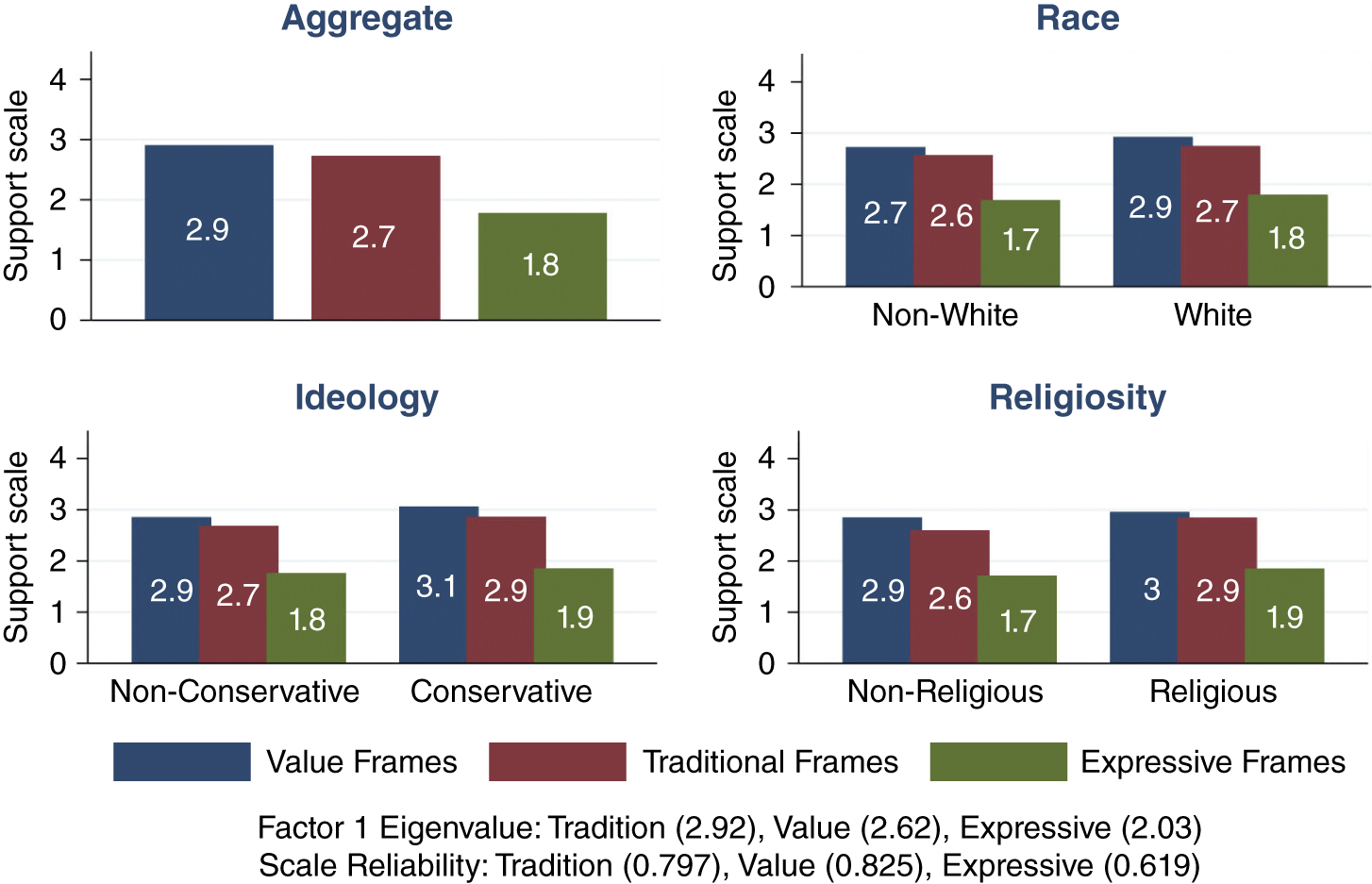
Figure 1 UK: Frame Clusterings
We examined specifically each of the three frames. For the values frame, whites, conservatives, and religious people were more likely to identify the component symbols as important for their English identity than non-whites, non-conservatives, and non-religious people (figure 2). The one exception was the value of “liberal,” which did not vary across subgroups. Whereas a number of individual differences by subgroup were modest, some were very large, and a number were stark enough to be visible in the charts.
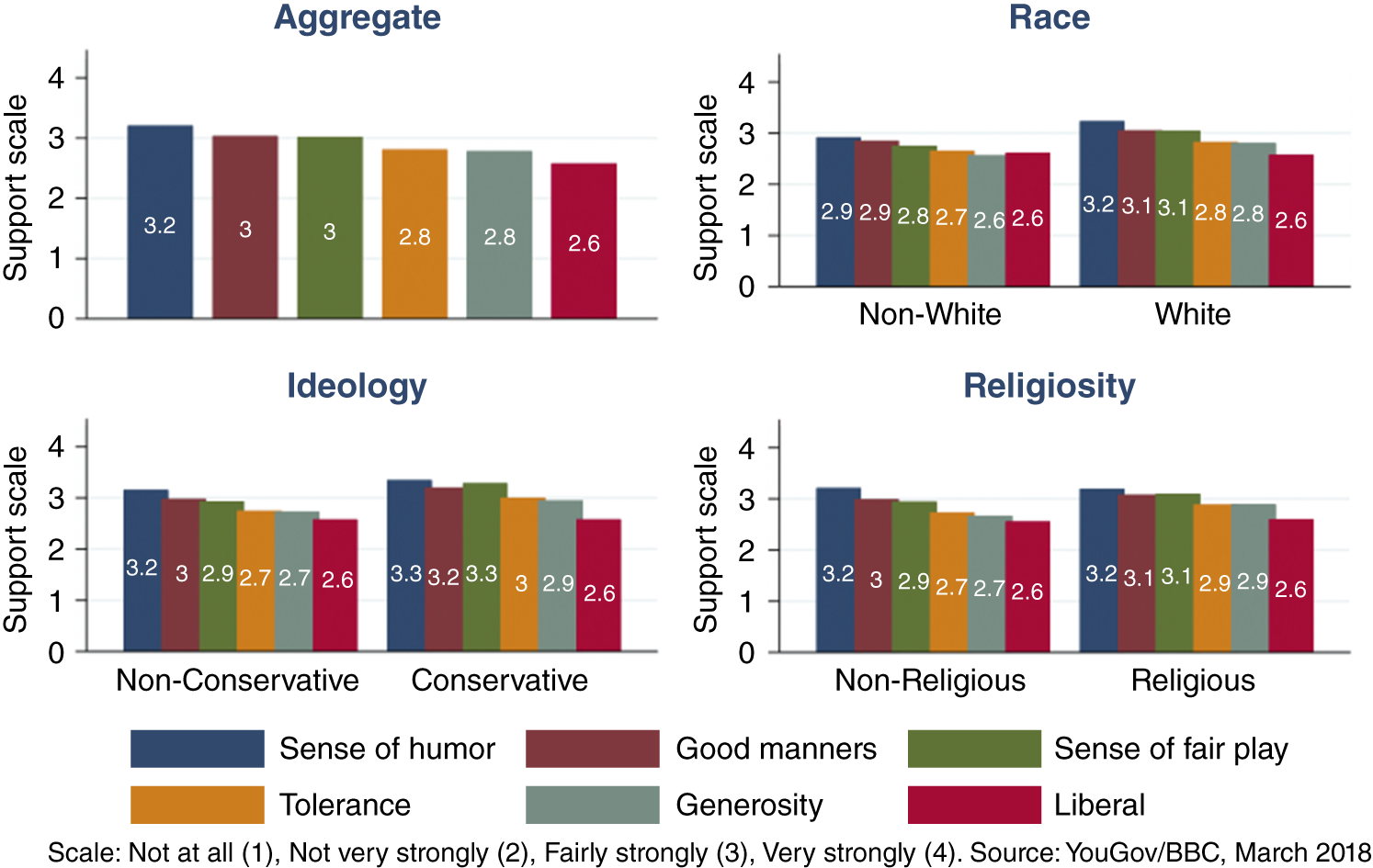
Figure 2 UK: Value Frames
For the traditional frames (figure 3), there also were subgroup differences across the component parts. Most illustrated that white, conservative, and religious respondents perceived this set of symbols as more important for their English identity than other respondents, although “diverse cultural life” displayed the opposite pattern. In addition, some of the substantive differences were not very large. “Christian tradition,” which showed the greatest variation (notably between Christian and non-religious respondents), differed by only 1 point (on a 5-point scale) across all three subgroups. This again demonstrates how the question was not eliciting approval of the symbols but rather whether they are perceived as part of a person’s English national identity. It is possible to be either religious or non-religious and perceive the presence of a long-standing Christian tradition.
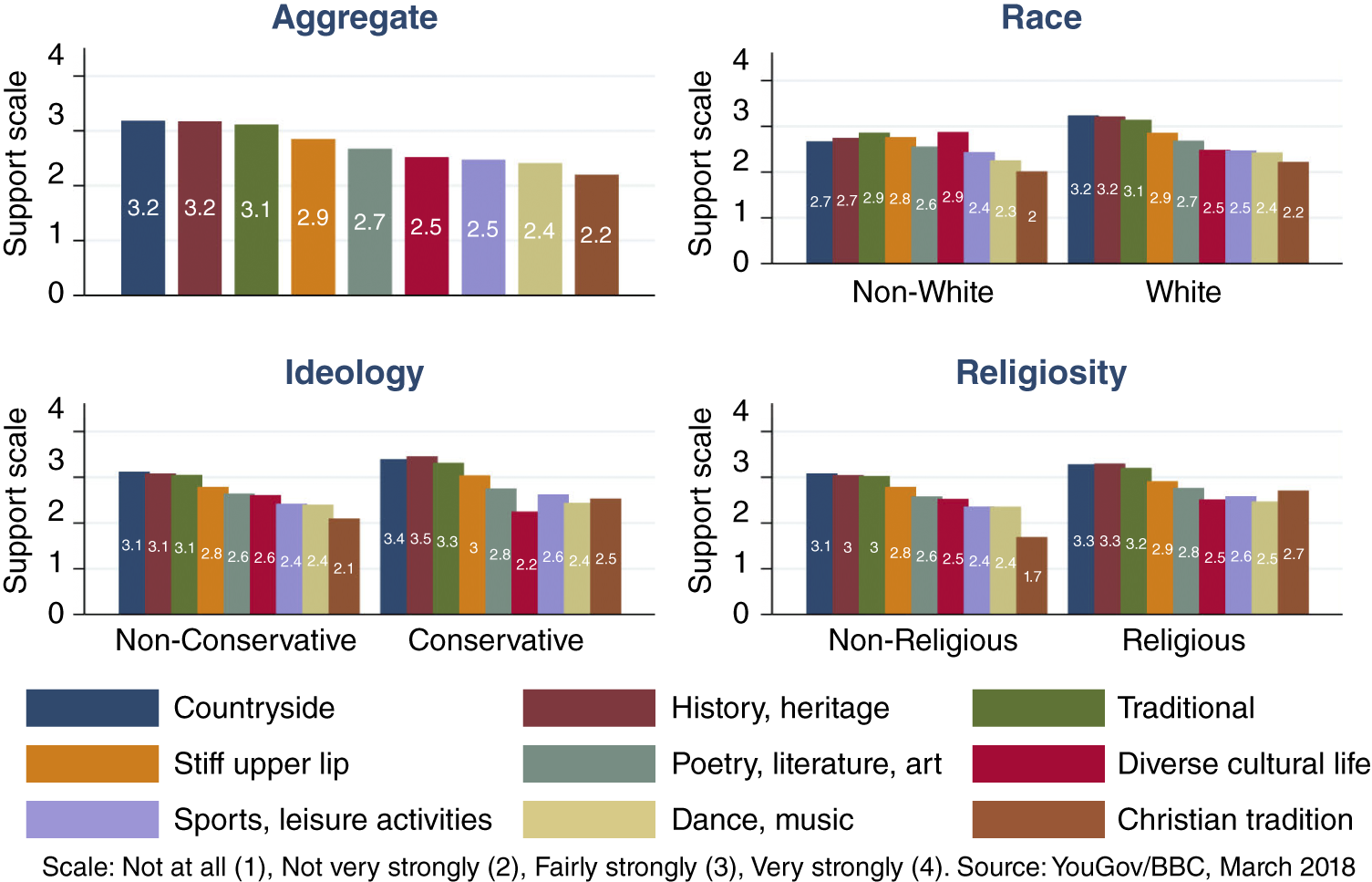
Figure 3 UK: Traditional Frames
Figure 4 shows the expressive frames, including factors such as “friendliness” and “welcoming.” The general pattern is repeated in which white, conservative, and religious respondents were more likely to identify the component parts as important for their English identity than non-white, non-conservative, and non-religious respondents. However, the opposite pattern held for “plain speaking” and “loud,” for which non-white, non-conservative, and non-religious respondents were as or more likely to identify these descriptors as English.
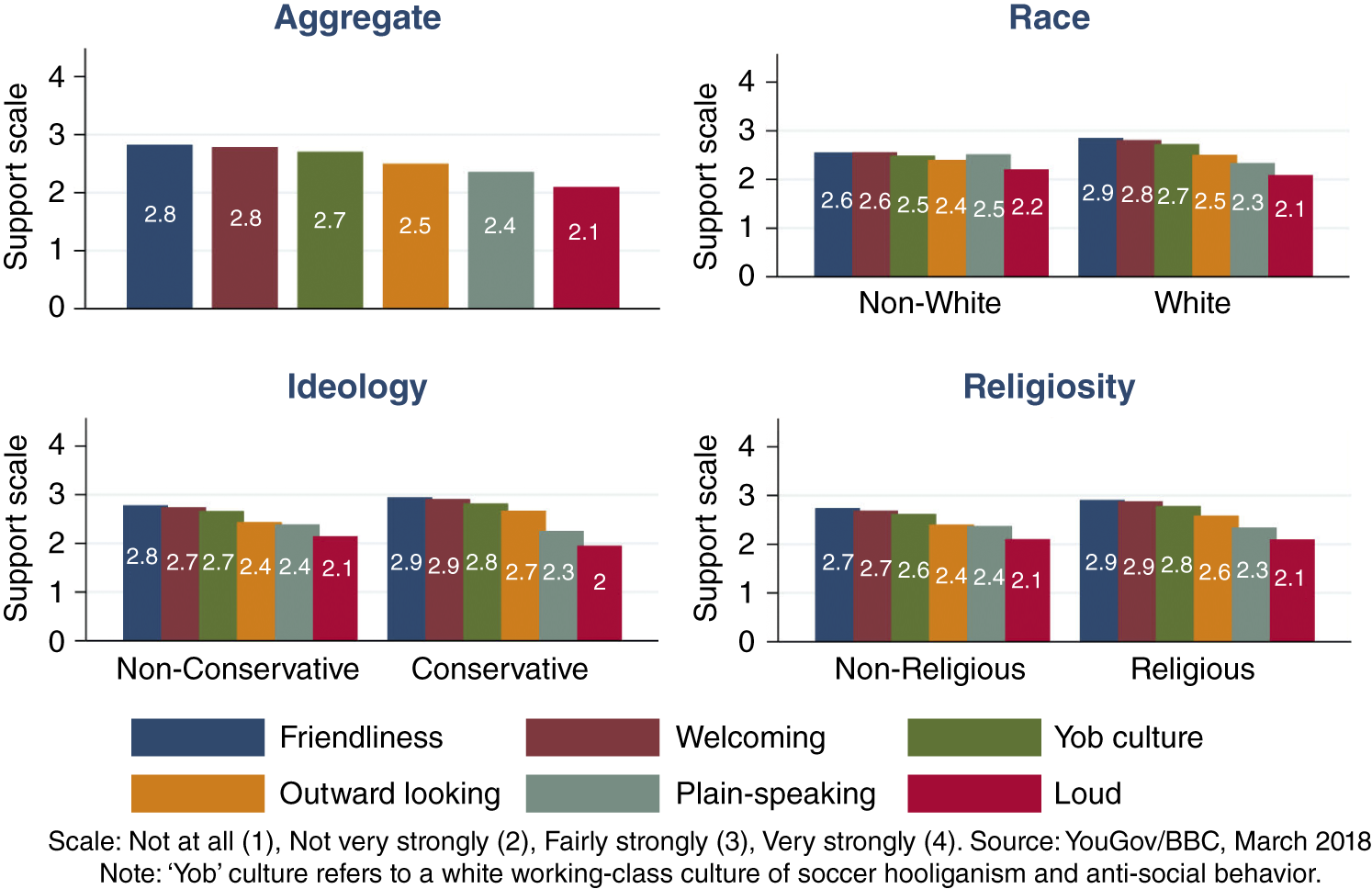
Figure 4 UK: Expressive Frames
ENGLISH MODELS
This section discusses the results of multivariate models that test how political and demographic factors shape views of the three frame clusters, as well as the independent effects of these clusters on voting in the 2017 election and the 2016 European Union (EU) referendum. A parallel set of results for the American case is in the online appendix.
Clusters
The regression models (see the online appendix) and the resulting plot of coefficients in figure 5 demonstrate that in a multivariate model, almost all of the variables are statistically significant. Whites, conservatives, and religious people (and, in two of three models, older individuals) tended to view all three sets of symbols as more important for their English identity than other respondents. In addition, women were distinctive only in ranking traditional symbols as more important for their Englishness. More educated respondents were less likely to view all sets of symbols as key for their English identity than were other respondents, and those with higher incomes were less likely to view expressive symbols as English than were less-affluent respondents. In summary, older, white, conservative, religious, and less-educated respondents were more likely to identify these symbols as important for their Englishness, whereas younger, minority, less-conservative, less-religious, and more-educated respondents took the opposite view.
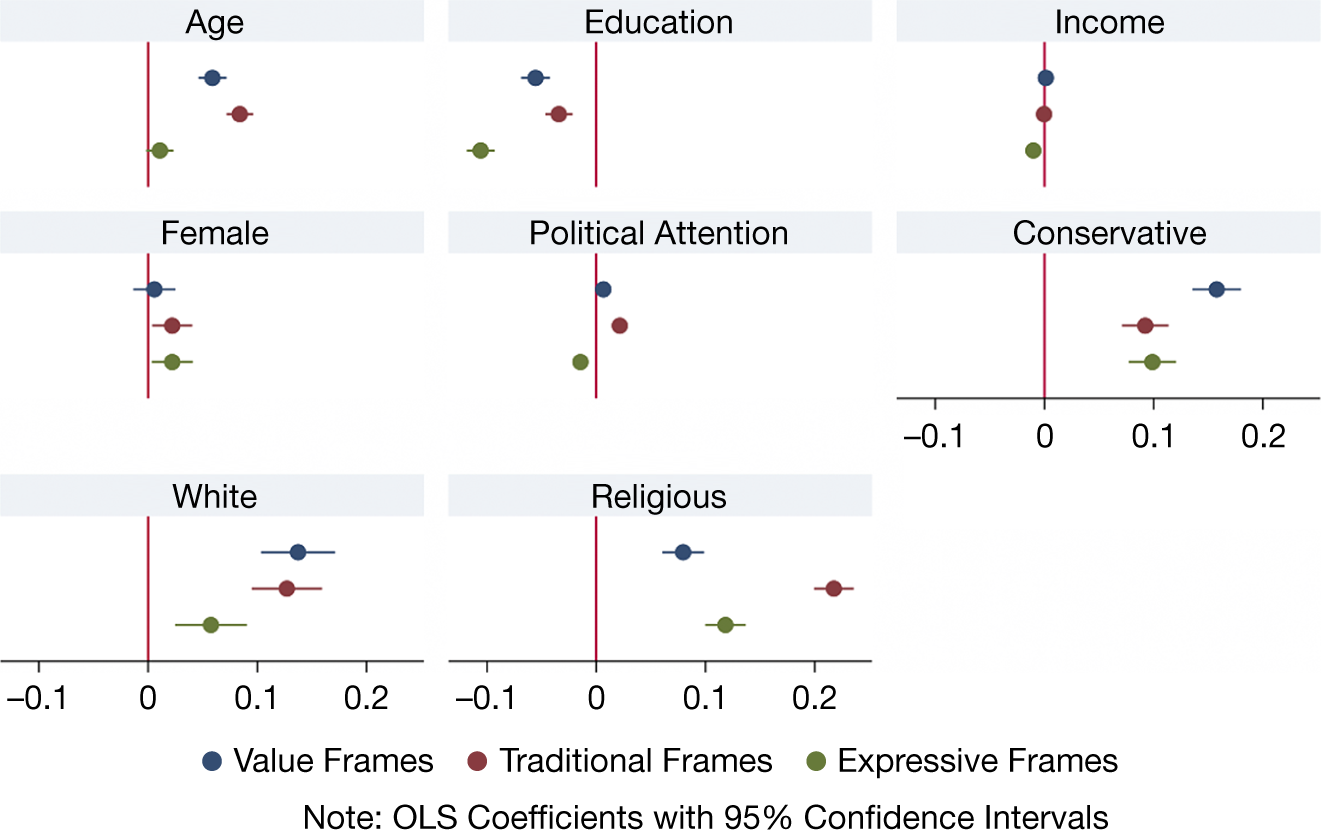
Figure 5 UK: Predictors of Frame Clusterings
Voting and Opinion
In the 2017 Conservative voting and 2016 EU referendum/Brexit voting models (see figure 6 and the online appendix), we found that variables measuring attachment to symbols—aggregated into an Englishness sentiment score for each of the three frame clusters—improved both models. The coefficients for the aggregate sentiment for each of the three frames were statistically significant in both models. It seems that understanding the contours of a person’s national identity can improve political science models of public opinion and voting. It may be that the data lack sufficient policy questions—notably immigration attitudes—to fully refute the null hypothesis that symbolic attachments are not doing the work in these models. This is an area for further research.
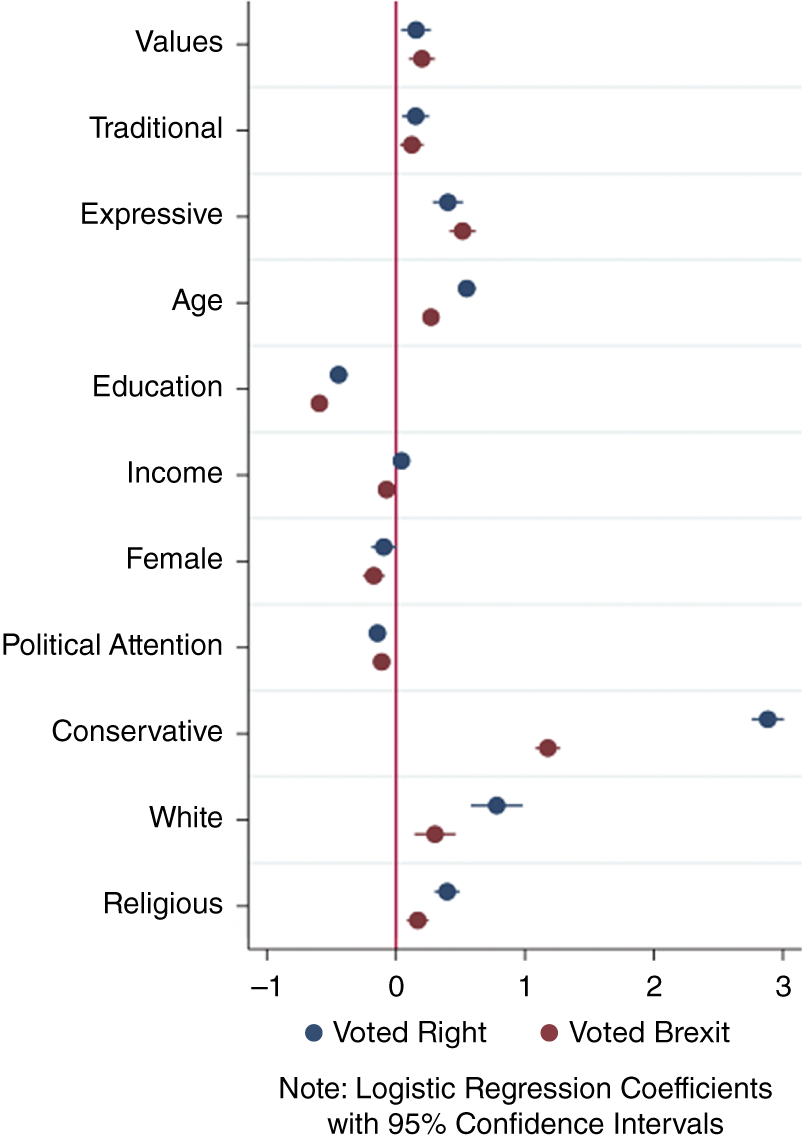
Figure 6 UK: Vote Choice
Figures 7 and 8 illustrate positive and statistically significant effects on general election and EU referendum voting for aggregate sentiment scores for all three frame clusters. Results for the Brexit vote were especially pronounced, with a difference of 30 points in the likelihood of voting Leave moving from the lowest to the highest points of attachment to symbols within the expressive frame. Drilling down to individual component symbols within each frame cluster reveals wider differences. For instance, 62% of Remain voters valued England’s “diverse cultural life” compared to only 38% of Leave voters. These individual items will be explored in future analysis.
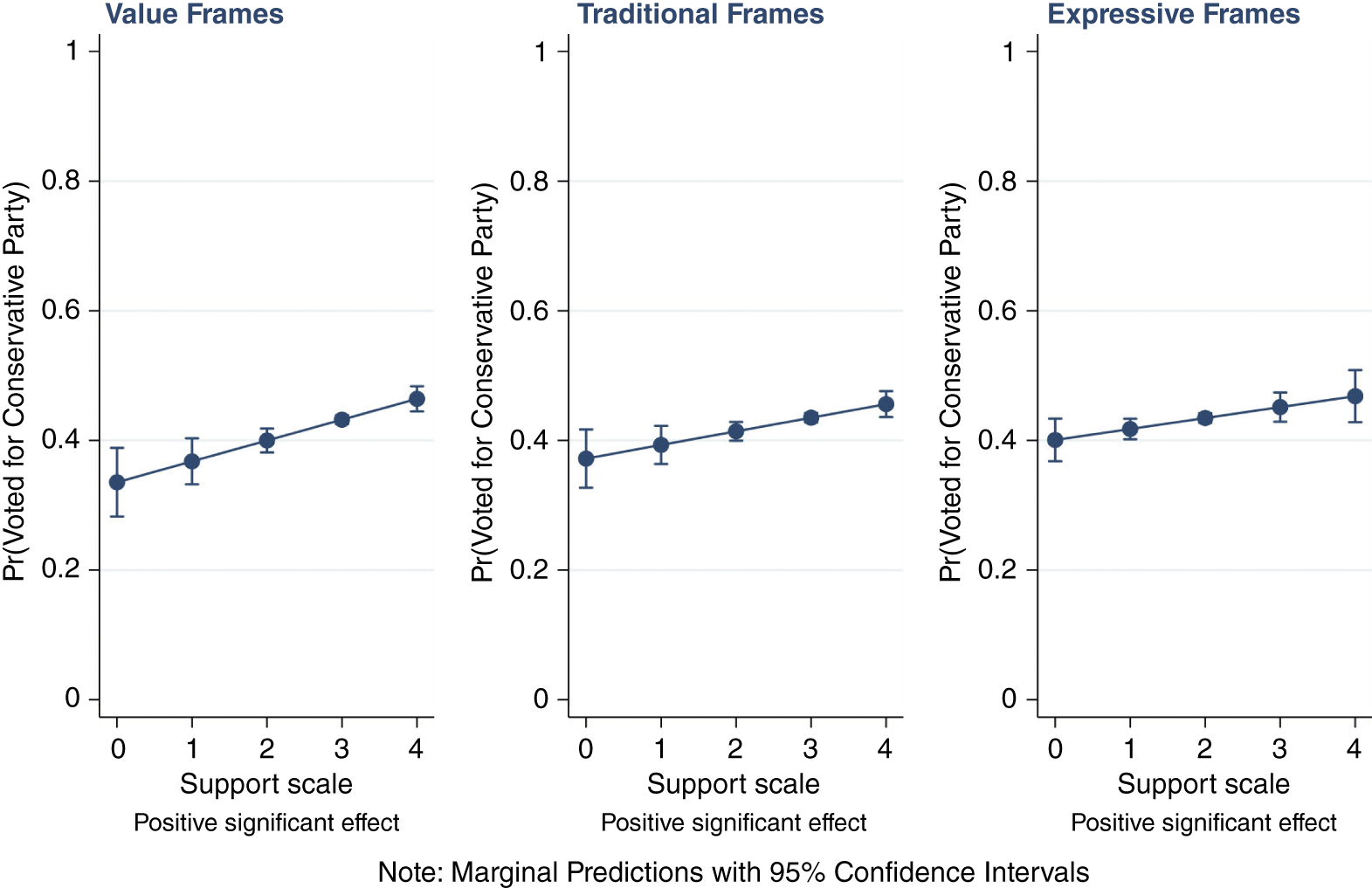
Figure 7 UK: Effect of National Frames on Conservative Vote 2017
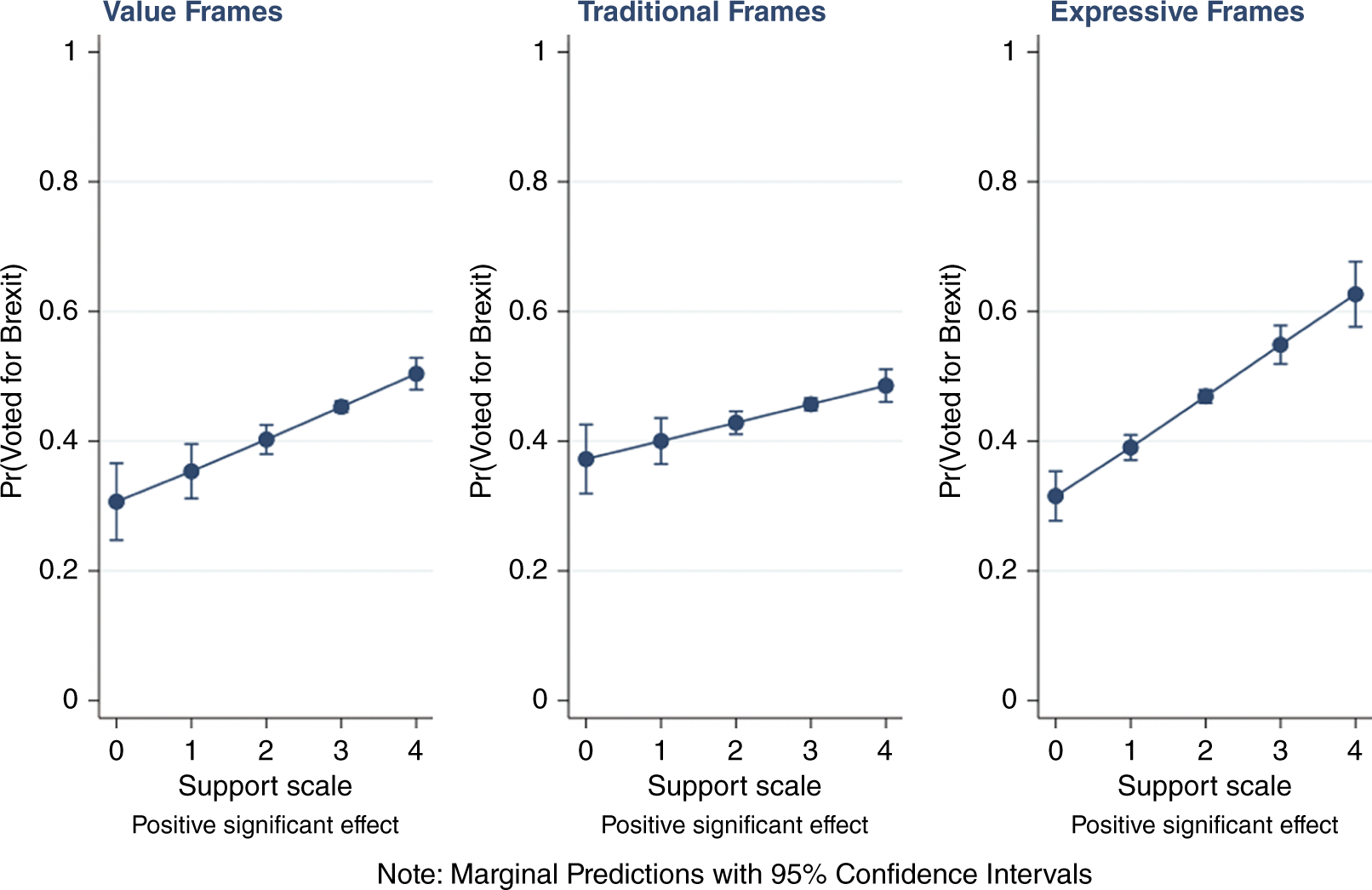
Figure 8 UK: Effect of Attachment to National Frames on Leave EU Vote
Figures 9–11 illustrate the marginal effects for particular frame clusters that differ by groups (i.e., Conservative/non-Conservative voters and religious/non-religious people). These effects represent the substantive effects of the statistically significant interaction terms in the regression models (see the online appendix). They indicate that the expressive frames (e.g., the English being welcoming and plain speaking) moderated the effect of ideology and religion on Conservative voting and Brexit, whereas the values frames (e.g., fair play and sense of humor) moderated how conservatives voted for Brexit. In particular, as the chart on the right side of figure 10 shows, non-Conservative voters (typically Labour and Liberal Democrat) who are attached to expressive symbols of Englishness were significantly more likely to be Brexit voters than Labour and Liberal Democrat voters who were less attached. Figure 11 shows that non-religious English people who are attached to expressive symbols were far more likely to be Conservative voters and Brexit voters than non-religious people who are less attached to these English symbols. This suggests that attachment to popular English national symbols is a more important predictor of voting among non-religious people than among those with a religious affiliation.
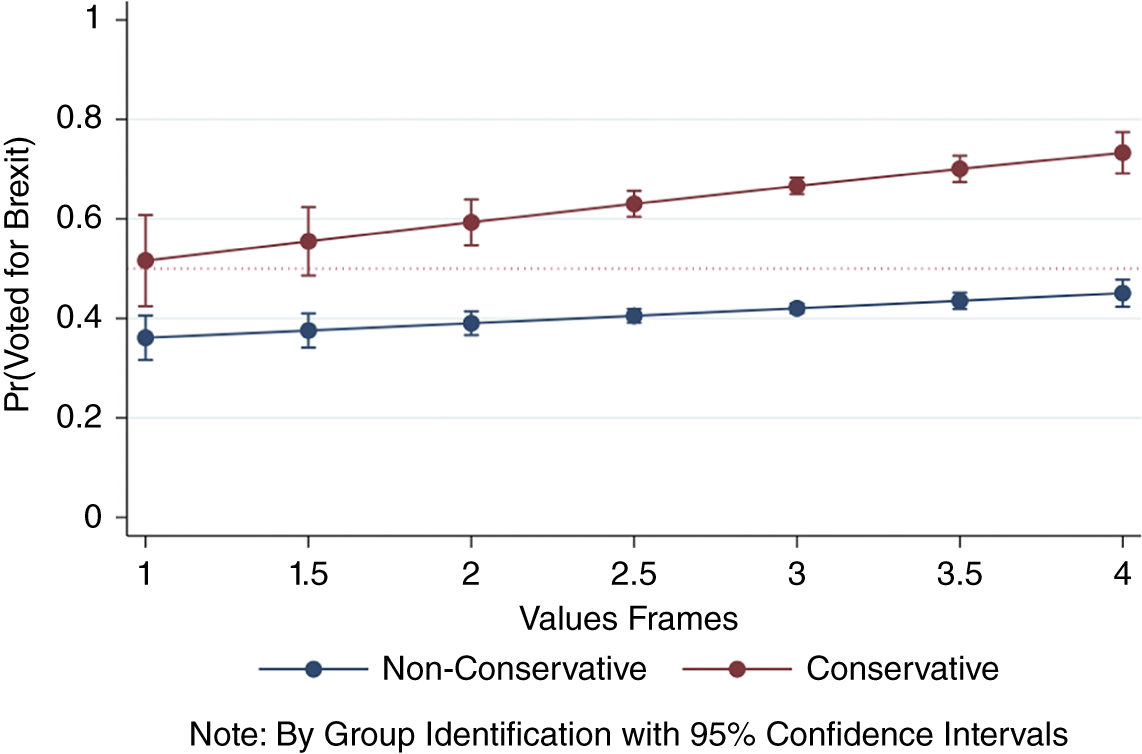
Figure 9 Marginal Effects of Attachment to Values Frames on Referendum Vote
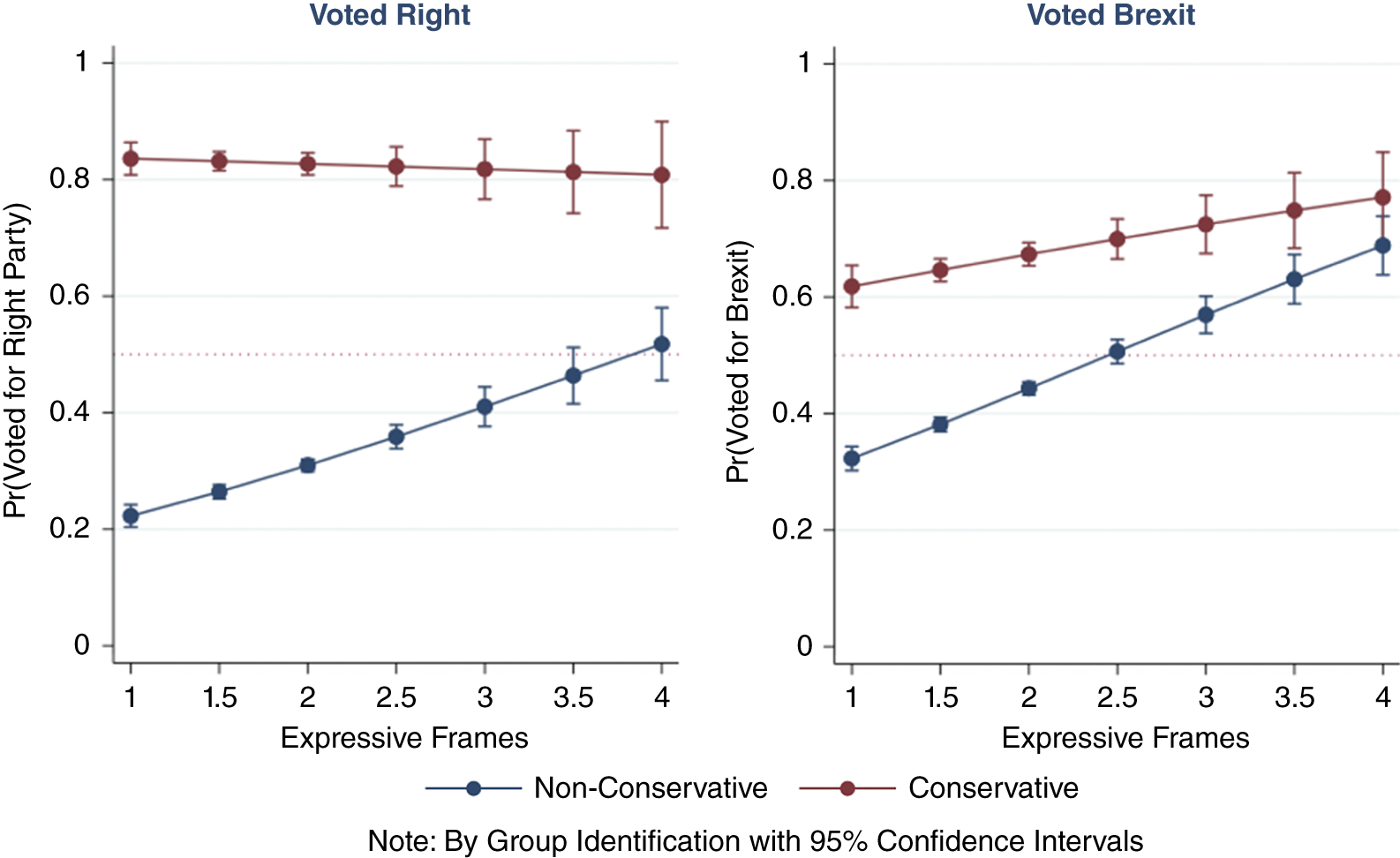
Figure 10 Marginal Effects of Attachment to Expressive Frames on Voting
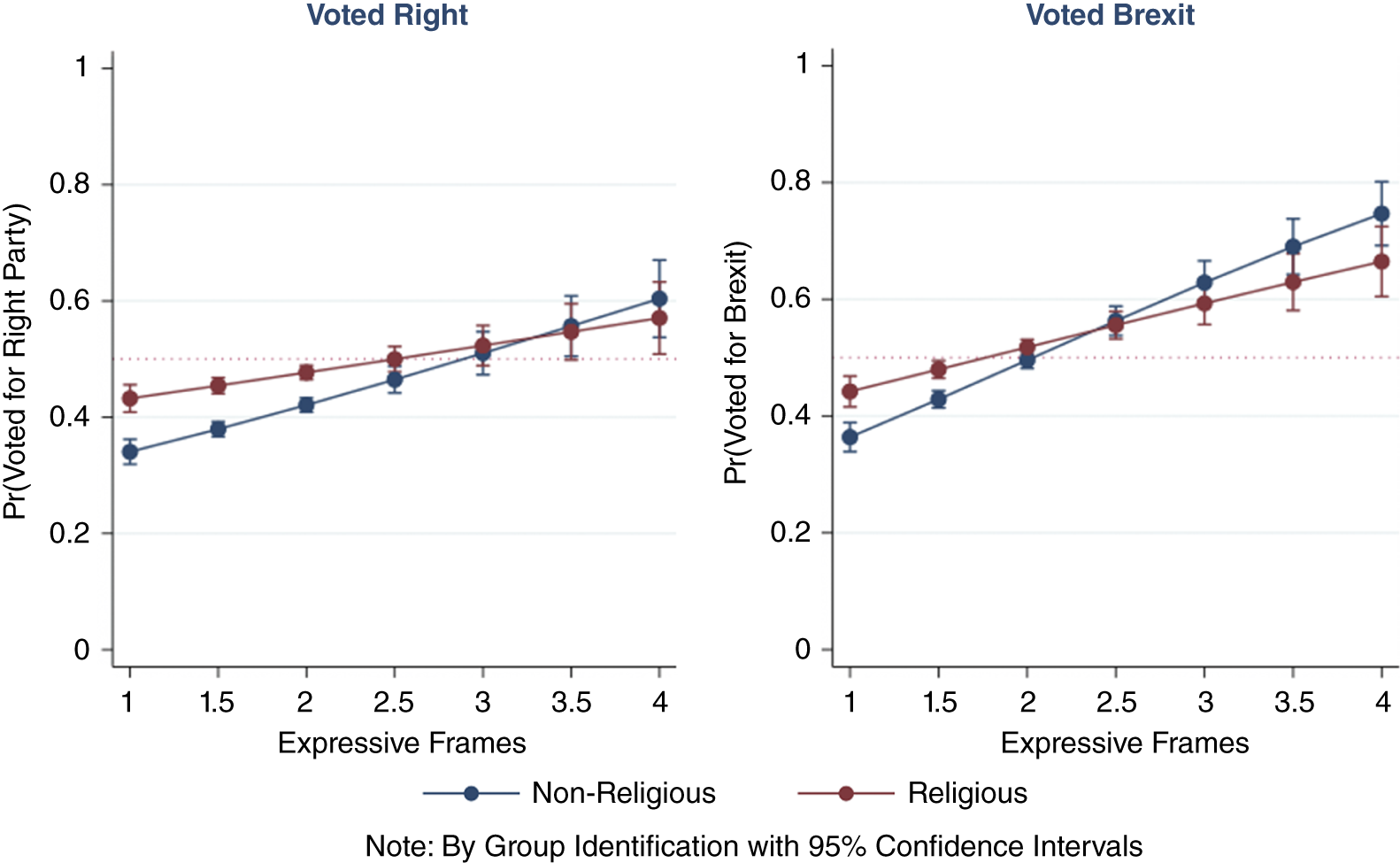
Figure 11 Marginal Effects of Attachment to Expressive Frames on Voting
CONCLUSION
Research on nationalism increasingly recognizes that nations are constructed from below by peer-to-peer interactions, everyday experiences, and popular culture. Rather than focusing on classic ethnic–civic questions of who belongs, our study examined which particular characteristics of the national experience and symbolic pantheon best resonated with respondents. Drawing on Smith’s (Reference Smith1986) ethnosymbolic approach, as well as the everyday nationalism literature, we found considerable variation in the content of people’s national identities.
As we expected, ideology, partisanship, religion, and race are all important lenses through which people view their nation. As a result, racial-ethnic majorities and minorities, and those who identify with different parties and ideologies (and with religion in general), are attached to different aspects of nationhood. The focus on more secondary symbols rather than “official” constitutions, icons, and values illustrates just how varied the nature of national identity is among the English people (as well as Americans; see the discussion in the online appendix). This also suggests that national identity can serve as a potent source of political division even if people are broadly in alignment on the “official” national symbols.
Indeed, these differing symbolic constructions are associated with populist–right issue positions and voting behavior in England—and to a lesser degree in the United States—even when controlling for demographics and party identification. Therefore, these results are important for both nationalism theory and political science. Future research could expand the range of national symbols tested, as well as the number of countries, to examine whether individuals’ competing versions of national identity—based on distinctive affective-aesthetic attachments—are independent drivers of political behavior. These studies also could map the extent to which segments of the public “consume” national symbols in various ways across different societies.Footnote 1
ACKNOWLEDGMENT
We thank Chris Curtis of YouGov for data access.
DATA AVAILABILITY STATEMENT
Research documentation and data that support the findings of this study are openly available at the PS: Political Science & Politics Harvard Dataverse at https://doi.org/10.7910/DVN/9KIMSV.
Supplementary Materials
To view supplementary material for this article, please visit http://doi.org/10.1017/S1049096523000471.
Competing interest
The authors declare that there are no ethical issues or conflicts of interest in this research.













